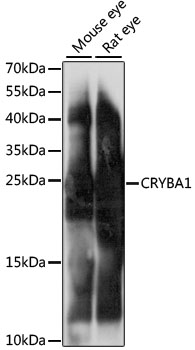CRYBA1 Polyclonal Antibody
For reference only. Please follow the manual included in your kit for instructions.
Catalog Number
RD88138A
Product Name
CRYBA1 Polyclonal Antibody
Catalog Number
RD88138A
Clonality
Polyclonal
Purification Method
Affinity purification
Isotype
IgG
Host
Rabbit
Background
Crystallins are separated into two classes: taxon-specific, or enzyme, and ubiquitous. The latter class constitutes the major proteins of vertebrate eye lens and maintains the transparency and refractive index of the lens. Since lens central fiber cells lose their nuclei during development, these crystallins are made and then retained throughout life, making them extremely stable proteins. Mammalian lens crystallins are divided into alpha, beta, and gamma families; beta and gamma crystallins are also considered as a superfamily. Alpha and beta families are further divided into acidic and basic groups. Seven protein regions exist in crystallins: four homologous motifs, a connecting peptide, and N- and C-terminal extensions. Beta-crystallins, the most heterogeneous, differ by the presence of the C-terminal extension (present in the basic group, none in the acidic group). Beta-crystallins form aggregates of different sizes and are able to self-associate to form dimers or to form heterodimers with other beta-crystallins. This gene, a beta acidic group member, encodes two proteins (crystallin, beta A3 and crystallin, beta A1) from a single mRNA, the latter protein is 17 aa shorter than crystallin, beta A3 and is generated by use of an alternate translation initiation site. Deletion of exons 3 and 4 causes the autosomal dominant disease 'zonular cataract with sutural opacities'.
Immunogen Information
Immunogen
Recombinant fusion protein of human CRYBA1
Gene ID
1411
Swissprot
P05813
Synonyms
CRYBA1CRYB1CTRCT10
Calculated MW
22kDa
Observed MW
22kDa
Applications
Reactivity
Mouse,Rat
Tested Applications
WB
Conjugation
Unconjugated
Dilution
WB 1:200-1:2000
Concentration
1mg/mL
Storage Buffer
PBS with 0.01% thiomersal,50% glycerol,pH7.3.
Storage Instructions
Store at -20°C Valid for 12 months. Avoid freeze / thaw cycles.
